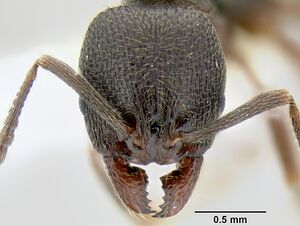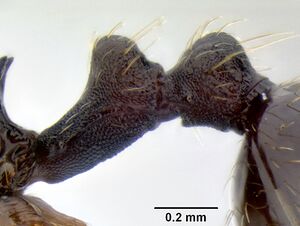Stenamma longinoi
| Stenamma longinoi | |
|---|---|

| |
| Scientific classification | |
| Kingdom: | Animalia |
| Phylum: | Arthropoda |
| Class: | Insecta |
| Order: | Hymenoptera |
| Family: | Formicidae |
| Subfamily: | Myrmicinae |
| Tribe: | Stenammini |
| Genus: | Stenamma |
| Species: | S. longinoi |
| Binomial name | |
| Stenamma longinoi Branstetter, 2013 | |
This species is known from a single collection event made in mesophyll forest at 1680 m elevation. A few workers were found under epiphytes in a treefall. Over 100 leaf litter samples were collected from the same site and no additional specimens were retrieved. Consequently, this species is likely to be arboreal in its habits.
Identification
Integument mostly dark brown to dark red-brown; large-sized species(see HL, ML, PrW below); lateral margin of hypostomal bridge with a projecting quadrate lobe (visible behind mandible in profile); gaster, and most dorsal surfaces, with a layer of thickened suberect to subdecumbent setae, gaster also with sparse layer of thinner appressed setae; mesosoma, waist, and head densely punctate (punctae fainter on head); head and mesosoma with fine rugulae and rugoreticulae, which on the mesosoma merge into the punctae, making them less obvious; eye relatively small (EL 0.13–0.16, REL 13–15), oval-shaped, with 6–7 ommatidia at greatest diameter; anterior clypeal margin with a shallow median emargination; basal margin of mandible straight to slightly sinuous, without a basal notch or depression; propodeal spines short (PSL 0.16–0.19, PSI 1.4–1.6), frontal lobes narrow (FLD 0.24–0.27, FLI 26), not obscuring torular lobes in full-face view.
Stenamma longinoi is similar to Stenamma leptospinum, Stenamma manni and Stenamma muralla., mainly because all share the lateral hypostomal lobe. However, S. longinoi is very distinct and should be easily separated from these other species by its punctate sculpture and thickened setae.
Keys including this Species
Distribution
Southern Mexico.
Latitudinal Distribution Pattern
Latitudinal Range: 15.72212° to 15.72212°.
| North Temperate |
North Subtropical |
Tropical | South Subtropical |
South Temperate |
- Source: AntMaps
Distribution based on Regional Taxon Lists
Neotropical Region: Mexico (type locality).
Distribution based on AntMaps
Distribution based on AntWeb specimens
Check data from AntWeb
Countries Occupied
| Number of countries occupied by this species based on AntWiki Regional Taxon Lists. In general, fewer countries occupied indicates a narrower range, while more countries indicates a more widespread species. |

|
Estimated Abundance
| Relative abundance based on number of AntMaps records per species (this species within the purple bar). Fewer records (to the left) indicates a less abundant/encountered species while more records (to the right) indicates more abundant/encountered species. |

|
Biology
Castes
Only known from the worker caste.
Worker
Images from AntWeb
      
| |
| Paratype Stenamma longinoi. Worker. Specimen code jtlc000007476. Photographer Michael Branstetter, uploaded by Default Group. | Owned by USNM. |
 
| |
| Holotype Stenamma longinoi. Worker. Specimen code jtlc000007475. Photographer Michael Branstetter, uploaded by Default Group. | Owned by USNM. |
Nomenclature
The following information is derived from Barry Bolton's Online Catalogue of the Ants of the World.
- longinoi. Stenamma longinoi Branstetter, 2013: 156, fig. 109 (w.) MEXICO (Chiapas).
- Type-material: holotype worker, 3 paratype workers.
- Type-locality: holotype Mexico: Chiapas, Custepec, 15.72212°N, 92.94428°W±30 m., 1860 m., 19.v.2008, JTL6297 (J. Longino); paratypes with same data.
- Type-depositories: USNM (holotype); CFSS, MCZC, MGBC (paratypes).
- Distribution: Mexico.
Unless otherwise noted the text for the remainder of this section is reported from the publication that includes the original description.
Description
Worker
(4 measured) HL 1.02–1.13 (1.12), HW 0.92–1.05 (1.01), FLD 0.24–0.27 (0.26), PCW 0.05–0.08 (0.08), SL 0.79–0.85 (0.83), EL 0.13–0.16 (0.13), ACL 0.67–0.74 (0.74), ML 1.29–1.41 (1.36), PSL 0.16–0.19 (0.17), SDL 0.10–0.13 (0.10), PrW 0.57–0.64 (0.61), PL 0.46–0.49 (0.49), PH 0.29–0.32 (0.30), PW 0.22–0.25 (0.24), PPL 0.27–0.30 (0.30), PPH 0.26–0.30 (0.29), PPW 0.28–0.31 (0.30), MFL 0.93–1.03 (1.02), MTL 0.57–0.80 (0.57), CI 91–93 (91), SI 81–88 (82), REL 13–15 (13), FLI 26 (26), PSI 1.4–1.6 (1.6), MFI 99–102 (99), ACI1 64–66 (64), ACI2 84–89 (89).
Large species; general body color dark brown (almost black) to dark red-brown, with appendages and some parts of the gaster lighter brown; setae a rich golden brown; mandible with 6 teeth, middle 2 teeth near basal tooth sometimes worn and indistinct; basal margin of mandible straight to slightly sinuous, without a basal notch or significant depression; mandible mostly smooth and shining with scattered piligerous punctae and striae; anterior clypeal margin with a median emargination; median lobe of clypeus with a pair of faint longitudinal carinulae that diverge anteriorly, area in between carinulae slightly depressed, apex of median lobe with a short transverse carinula, remainder of clypeus mostly smooth and shiny; posterior extension of clypeus between antennal insertions of moderate width (PCW 0.05–0.08), sides slightly hourglass-shaped; frontal lobes narrow (FLD 0.24–0.27, FLI 26), not obscuring torular lobes in full-face view; lateral margin of hypostomal bridge with a projecting quadrate lobe (visible behind mandible in profile); head robust, somewhat heart-shaped (CI 91–93), with posterior margin broadly depressed medially; eye relatively small compared to HW (REL 13–15), but appearing of moderate size (EL 0.13–0.16), with 6–7 ommatidia at greatest diameter, oval-shaped; face densely sculptured with longitudinal carinulae and rugulae, becoming rugoreticulae toward lateral margins, interstitial areas noticeably punctate; scape relatively short (SI 81–88), not reaching posterior margin of head when laid back; scape surface with scattered carinulae and faint piligerous punctae; flagellum with a somewhat indistinct 4-segmented antennal club; mesosoma densely punctate, and with fine rugulae that merge into surrounding punctae; rugulae on anterior half of pronotal dorsum transversely arcuate across surface; rugulae on remainder of promesonotal dorsum longitudinal in orientation; pronotal side completely punctate; rugulae on mesopleuron somewhat reticulate; part of propodeal dorsum and declivity with transverse carinulae; promesonotum in profile low-domed and asymmetrical, with apex occurring anterior of midpoint; metanotal grove somewhat indistinct with anterior margin merging smoothly with promesonotal declivity; propodeal spines well-developed, short (PSL 0.16–0.19, PSI 1.4–1.6); petiole of moderate length and robust (PL/HW 0.47–0.50), node of moderate height (PH/PL 0.62–0.65), broadly domed, and pointing slightly posteriad; postpetiole in profile nearly symmetrical, somewhat bulging, about as high as petiolar node (PPH/PH 0.90–0.96); petiole and postpetiole completely punctate and with a few rugulae on posterior sides of nodes; gaster mostly smooth and shiny, with scattered piligerous punctae; much of dorsal body surface with a layer of stout standing setae; setae on scape thin, dense, and decumbent (almost pubescent); gaster with a short layer of thickened suberect to subdecumbent setae and a very sparse layer of thinner appressed setae; setae on legs mostly appressed, with a few suberect setae on the coxae and femoral venters.
Type Material
Holotype worker. MÉXICO: Chiapas, Custepec, 15.72212°N, 92.94428°W ±30m, 1680m, 19 May 2008, mesophyll forest, under epiphytes in treefall (J. Longino, collection JTL6297) USNM, specimen JTLC000007475. Paratypes: same data as holotype 1w, ECOSCE, JTLC000007476; 1w, MGBPC, CASENT0603913; 1w, MCZ, CASENT0623106.
Etymology
The specific epithet longinoi is used in honor of the indefatigable myrmecologist and leader of the LLAMA project, Jack Longino.
References
- Branstetter, M. G. 2012. Origin and diversification of the cryptic ant genus Stenamma Westwood (Hymenoptera: Formicidae), inferred from multilocus molecular data, biogeography and natural history. Systematic Entomology 37:478-496. doi:10.1111/j.1365-3113.2012.00624.x.
- Branstetter, M.G. 2013. Revision of the Middle American clade of the ant genus Stenamma Westwood (Hymenoptera, Formicidae, Myrmicinae). ZooKeys 295, 1–277. doi:10.3897/zookeys.295.4905


